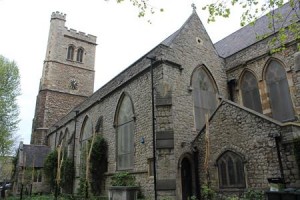
On this day in 1538, Elizabeth Boleyn, Lady Wiltshire, wife of Thomas Boleyn and mother of the late Queen Anne Boleyn, was buried in the Howard aisle of St Mary’s Church, Lambeth.
John Hussey recorded her funeral procession in a letter to Lady Lisle:
“My lady Wiltshire was buried at Lamehithe on the 7th… She was conveyed from a house beside Baynard’s Castle by barge to Lambeth with torches burning and four baneys (banners?) set out of all quarters of the barge, which was covered with black and a white cross.”1
Sir John Russell, Lord Comptroller, was the chief male mourner and Elizabeth’s half-sister, Katherine Howard, Lady Daubenay, was the chief female mourner. J. Nichols, in “History of the Parish of Lambeth” (1786), stated that there used to be a brass plate at St Mary’s Church, Lambeth, which was inscribed “Here lyeth the Lady Elizabeth Howard, some time Countess of Wiltshire”, but it no longer exists.
It is not known what Elizabeth died of but Thomas Warley had written to Lady Lisle in April 1536 about Elizabeth being “sore diseased with the cough, which grieves her sore”2 and Anne Boleyn commented “O, my mother, [thou wilt die with] sorow” to Sir William Kingston at her arrival at the Tower after her arrest on the 2nd May 1536.3 It is impossible to say whether Anne was simply worried that her mother would be heartbroken at the news of what had happened or whether she was concerned because her mother was already in ill health.
In May 2013 I took the opportunity to go to Lambeth, London, to visit the resting place of Elizabeth Boleyn. St Mary’s Church, Lambeth, is no longer a place of worship, it is now The Garden Museum. It is a bit of a disappointment for Tudor history fans because the Howard Chapel, where Elizabeth and other Howard family members were laid to rest, is now a café. However, we have to thank our lucky stars because if the Garden Museum had not been set up in 1977 to preserve the tomb of John Tradescant (c1570 – 1638 ), the famous botanist and gardener, the church would have been demolished. OK, so the Howard Chapel has a counter and tables, and people are sat there eating salads and drinking coffee, but the tombs have been preserved under the wooden floor. The museum has not messed with the structure of the building and no tombs have been desecrated, that had already been done in the Victorian rebuilding work.
It is frustrating that we can’t see Elizabeth’s tomb but she is there, somewhere under that floor.
Some people wonder if Elizabeth’s burial at Lambeth, rather than at Hever, is evidence of a breakdown in her marriage after the execution of her son and daughter, but I feel that this is reading far too much into it. Elizabeth was a Howard woman and it appears to have been traditional for Howard women to be buried at Lambeth in the Howard Chapel. Norfolk House, the house where Catherine Howard spent part of her upbringing and the London home of the Howard family, was just down the road and Elizabeth died in London. Just what she was doing at the home of the Abbot of Reading is a mystery, but perhaps she was taken ill nearby and then died there. Whatever the truth of the matter, there is no evidence that Elizabeth and Thomas Boleyn had marital problems.4
Here is a slideshow of photos I took at Lambeth showing the exterior of Lambeth Palace (the red brick building) and the exterior and interior of the Garden Museum (formerly St Mary’s Church), where Elizabeth is buried.
[slideshow id=580 w=450 h=300]
Notes and Sources
- LP xiii Part 1, 717
- LP x. 669
- Ibid., 793
- The section about my visit to Lambeth is taken from my book The Anne Boleyn Collection II, p251-252